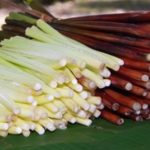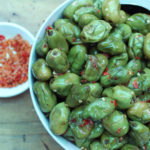For those from the Mekong Delta region of Vietnam, the sake fruit is a well-known delicacy. This versatile fruit can be fried, baked, or used in soups, always resulting in a delicious dish. However, for those outside of this region, especially the people of Hanoi, sake fruit is still relatively unknown. This article aims to provide a comprehensive guide to sake fruit, so read on to discover more about this unique produce.
1. What is Sake Fruit? Characteristics and Features

At first glance, the sake fruit bears a striking resemblance to a jackfruit, with a similar outer appearance and a tendency to grow in clusters. However, it is smaller than a jackfruit, and while it has small spikes when unripe, these open up as the fruit matures, revealing a seedless interior with thick, white flesh.
Sake fruit typically ripens in April, and the main harvest season falls in July each year. This fruit is highly nutritious, containing approximately 103 kcal, 11g of sugar, 4.9g of protein, and various other nutrients per 100g of fresh fruit.
2. How to Prepare and Cook with Sake Fruit
Preparing sake fruit is straightforward. Simply peel and slice the fruit, then soak the pieces in a dilute salt water solution for 15-20 minutes to reduce the natural latex. After this, rinse the fruit with clean water and it’s ready to be used in a variety of dishes.

Sake fruit is incredibly versatile in the kitchen. It can be fried, boiled, or made into a soup, porridge, salad, or even a dessert. The texture is soft and buttery, with a sweet and creamy flavor that adds a delicious touch to any dish.
If you have any leftover sake fruit, you can store it in the freezer for up to 7-8 months! Simply place the fruit in a bag and pop it into your freezer.
3. How to Choose Ripe and Delicious Sake Fruit

Selecting ripe and tasty sake fruit is not difficult. Look for firm fruit with a yellow-green hue, fully opened spikes, and a weight of at least 7 taels (approximately 250g).
A ripe sake fruit will have a creamy white or light yellow flesh with minimal latex. When cooked, it will be tender, sweet, and slightly sticky—a truly delightful treat.
On the other hand, unripe sake fruit will have a higher latex content, resulting in a chewy texture and a less sweet flavor.
4. How Much Does Sake Fruit Cost and Where Can I Buy It?

The price of sake fruit can vary depending on the season and availability, ranging from 20,000 to 55,000 VND per kilogram. At the start of the season, prices may be higher, around 55,000 VND per kilogram, but during off-peak periods, such as the current pandemic, prices can drop to around 40,000 VND per kilogram. As the main harvest season approaches, prices tend to decrease.
When transported to Hanoi, the price may increase slightly to account for shipping costs. You can find sake fruit at specialty shops selling Mekong Delta produce, as well as local markets and supermarkets across the country. Remember to choose a reputable seller to ensure the best quality and taste.
Sake fruit is a unique and delicious treat. We hope that this article has piqued your interest in this wonderful fruit. If you get the chance, be sure to try it and discover its delightful flavor for yourself!




































